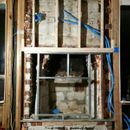Air sealing & insulating an exterior chimney
This is somewhat of a two part question, first i have to address air sealing and framing temperatures directly above my gas insert. Second I need to address the optimum way to insulate with roxul, and where to place sheet metal air seals.
I recently converted my masonry wood burning fireplace to a gas insert. One of the aesthetic issues we had was that the original fireplace was not centered on the wall, so after I removed the veneer brick, not confident of what is safe to remove and what isnt, i hired a chimney mason. I wanted to remove the firebrick on the left side of the box, which would get my insert to approximately center, when set adjacent to the remaining brick.
Due to past water damage, we also reframed the wall at the chimney, and now have realized that the air sealing & insulation are a major mess, I need to remove and rework the area as best i can tell. Reading other chimney articles & questions on GBA I have found i have the following issues:
1. No spray foam against the masonry – easy to fix, will wirebrush out and switch to fire caulk.
2. Pyrophoric concerns at 170F on the wood, tested the wood header’s temperature directly above the center of the insert at 45 min operation on max heat with no fan, 165F, not going to be acceptable for long term safety. (Fireplace had been operating at max heat for 2 hrs prior to the test with max heat, exterior temps were at <35F) 3. removal of firebox has hot air path directly into the attic, no existing air seal between top plates and chimney exists 4. I see comments where roxul can not fill the airgap between the framing and the fireplace, however when i read the linked building codes, i dont interpret it that way… the roxul i installed does fill the airgap, however it is attached to my framing, not the masonry, is this still unacceptable? Attached photo was prior to installation of roxul to help see the masonry and framing. My Plan: Part 1: 1. Addition of a sheet metal or 1/4″ hardibacker box from the fireplace opening to the masonry to prevent hot air from rising up the gap (The old removed course of masonry served this purpose) 2. Less ideal, but remove all wood studs from the wall, temperatures abate rapidly once clear of the open cavity. 165F at the opening / header stud, just 6″ above the cavity, temps drop to <100F. Part 2: 3. Add flashing with fire caulk to the top plate of the wall and to the masonry to prevent house air from reaching into the roof. I’m not certain how the best route is to seal the attic from the framing to masonry gap is beyond this. Am I on the right track?
GBA Detail Library
A collection of one thousand construction details organized by climate and house part










Replies
Jon,
In general, this is a good location for steel studs, not wood studs.
The code specifies a minimum gap (generally 2 inches) between a masonry chimney and framing lumber. This 2 inch gap can't be filled with any type of insulation, but it can be bridged with metal flashing to create an air barrier.
A third alternative Ive thought of this morning is to add an angle iron lintle at the top of the present metal framing, i can then lay a course of bricks to close the cavity which would abate the hot air leakage between the insert and the wall/chimney.
Can someone explain why the insulation gap is required? I really don't understand it from any safety perspective. I'm sure there is a reason the provision exists, but i dont get it...